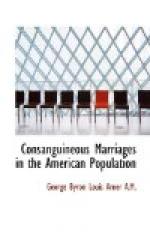----- Parents cousins. | | | | | —Totally blind | 1,291| 435 | 78 | 739 | 39 Parents cousins. | | | | | —Partially blind | 1,236| 409 | 71 | 717 | 39 | | | | | Parents not cousins.| | | | | —The blind |53,980| 7,395 | 2,095 | 43,368 | 1,122 ------------------------------------------------------------
----- Parents not cousins.| | | | | —Totally blind |29,892| 3,720 | 1,090 | 24,541 | 541 Parents not cousins.| | | | | —Partially blind |24,088| 3,675 | 1,005 | 18,827 | 581 | | | | | Consanguinity not | | | | | stated.—The blind | 8,256| 390 | 94 | 1,935 | 5,837 ------------------------------------------------------------
----- Consanguinity not | | | | | stated.--Totally | | | | | blind | 4,462| 223 | 47 | 1,069 | 3,123 Consanguinity not | | | | | stated.--Partially | | | | | blind | 3,794| 167 | 47 | 866 | 2,714 ------------------------------------------------------------
----- [A] Symbols for Blind Relatives—(a) blind brothers, sisters or ancestors; (b) blind collateral relatives or descendants.
Of the 2527 blind persons whose parents were cousins, 993 or 39.3 per cent have blind relatives, 33.4 per cent having blind brothers, sisters or ancestors, and 3.9 per cent having blind collateral relatives or descendants. And 9 per cent of the blind who have blind relatives are of consanguineous parentage, while but 3.1 per cent of the blind who have no blind relatives are the offspring of cousins. These figures alone indicate a decided intensification of blindness through consanguinity, although it should be remembered that a relationship “works both ways,” so that when a brother has a blind sister, the sister would have a blind brother. This fact has probably diminished the apparent number of sporadic cases of blindness.
Considered with reference to the degree of blindness the table shows that 1291 or 51.1 per cent of the blind of consanguineous parentage are totally blind, and 1236 or 48.9 per cent are partially blind. Among those whose parents were not cousins, 55.4 per cent were totally and 44.6 per cent were partially blind.
Of the 2527 blind of consanguineous parentage, 632 or 25.0 per cent were congenitally blind, of whom 350 or 55.4 per cent also had blind relatives of the degrees specified. Not counting those who did not answer the question in regard to blind relatives, we have 615 cases of which 51.5 per cent had blind relatives of class (a), and 5.4 per cent blind relatives of class (b). Taking the 53,980 blind whose parents were not so related the number of congenitally blind was 3666 or but 6.8 per cent, of whom 1023 or 27.9 per cent had blind relatives. Omitting as before the “blind relatives not stated,” we have 23.4 per cent who had blind relatives of class (a), and 4.3 per cent relatives of class (b).




